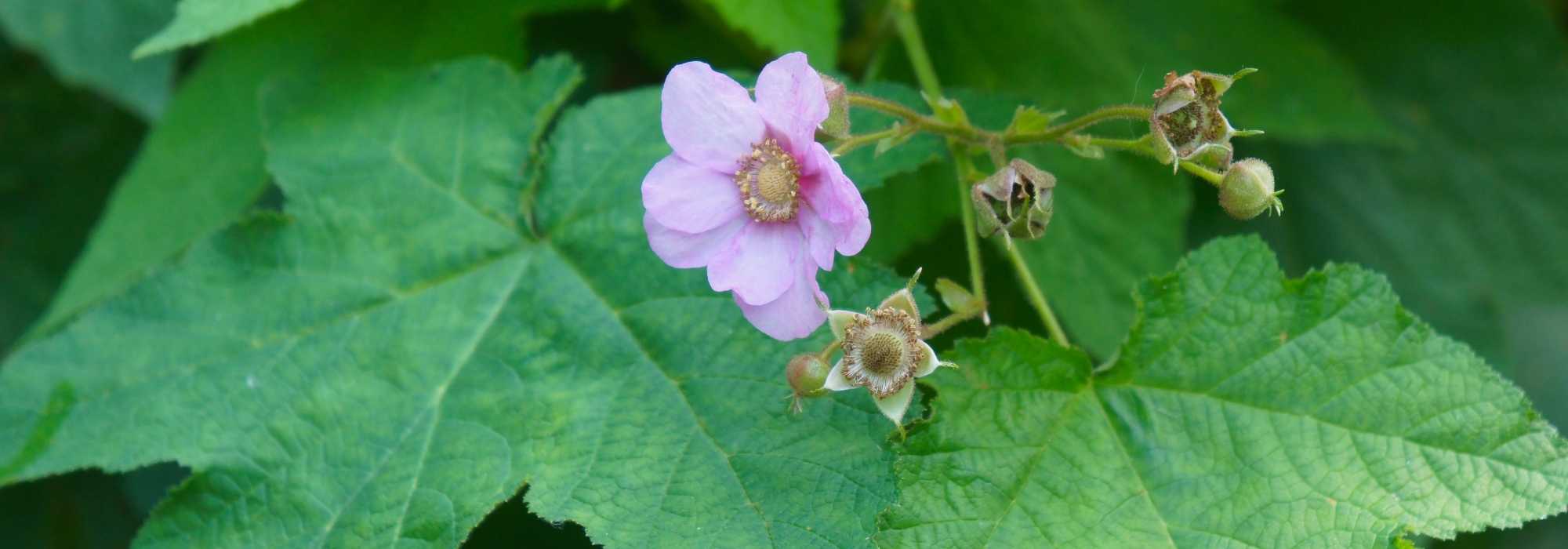
Rubus, ornamental bramble: how to choose and care?
Contents
Ornamental brambles in a nutshell
- Ornamental brambles are extremely vigorous bushes
- They thrive in fresh, humus-bearing soil
- Rubus can be used in free-standing hedges, in groups, as specimens, or as groundcover
- Ornamental brambles are very hardy and trouble-free
- Rubus offers appeal almost all year round thanks to their flowers, fruits, foliage, and even stems.
The word from our expert
Rubus or ornamental brambles (not to be confused with fruiting brambles) are vigorous plants that are very easy to grow. Depending on the species or varieties, they are wonderful as standalone plants, as groundcover under trees, or in a more rustic free-standing hedge.
First of all, one might consider Rubus thibetanus ‘Silver Fern’, an ornamental bramble of great beauty with a rapid growth rate. It reveals its best side in winter, as it displays numerous white stems that can reach two metres, forming a somewhat ghostly silhouette. In addition, its silver-green fern-like foliage, with white undersides, is adorned in summer with small pink flowers. The Canadian Raspberry or Fragrant Bramble (Rubus odoratus) is also very floriferous, slightly fragrant, and thornless. The Rubus henryi var. bambusarum is very vigorous and displays fine, flexible, thorny stems. This ornamental bramble features magnificent palmate foliage, resembling that of certain bamboos. However, there are also ornamental brambles that develop as groundcover, such as Rubus tricolor ‘Betty Ashburner’ with its evergreen foliage. In short, there are ornamental brambles for all uses, tastes, and gardens.
Ornamental brambles are shrubs that generally appreciate sun or partial shade, but some tolerate shade well. They will thrive in fresh, humus-bearing soil. It is worth noting that most do not have thorns.
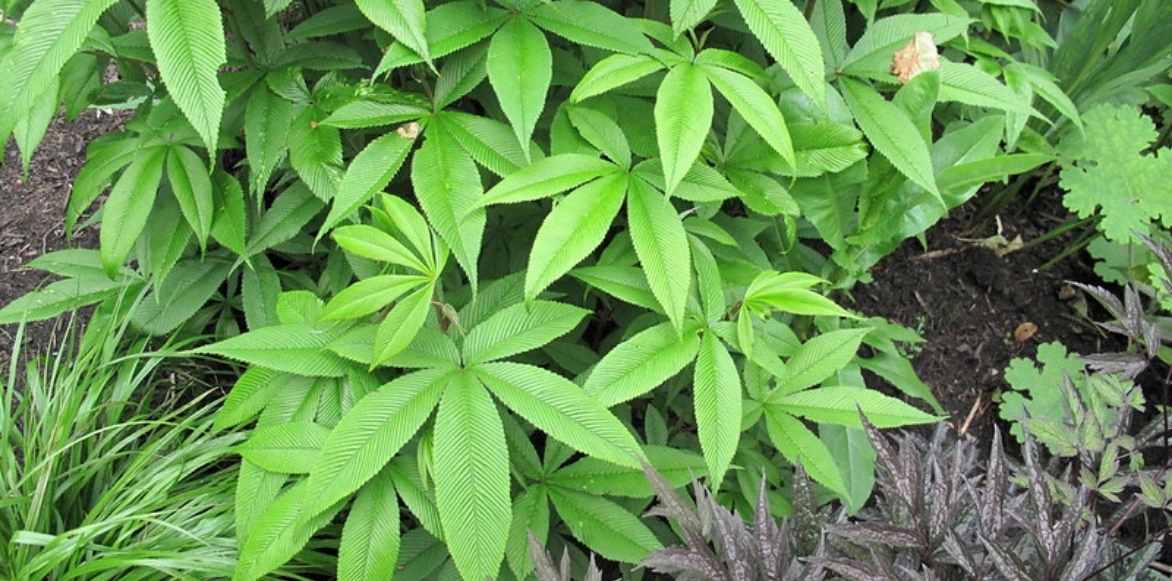
Rubus lineatus (© Megan Hansen)
Botany and description
Botanical data
- Latin name Rubus sp.
- Family Rosaceae
- Common name Ornamental brambles
- Flowering May to August depending on varieties and species
- Height up to 250 cm
- Exposure sun or partial shade
- Soil type humus-bearing and cool
- Hardiness -15°C
In the Rosaceae family, the genus Rubus is a very large botanical genus, comprising nearly 200 species according to phylogenetic classification (some authors counting even more than a thousand) and numerous varieties. Among this genus, we find the “fruiting Rubus” such as raspberry (Rubus idaeus) or blackberry (Rubus fructicosus), but there are also some stunning ornamental Rubus: the ornamental brambles. This sheet will focus on the most beautiful of them.
Rubus grow wild throughout the northern hemisphere.
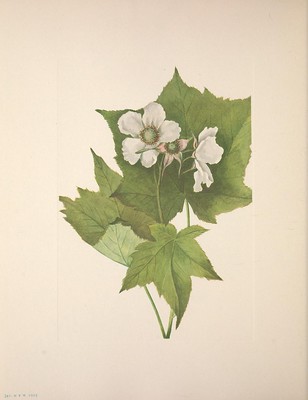
Rubus parviflorus, botanical plate circa 1925
Ornamental Brambles are shrubs (less than 4 m tall and branched from the base) with a perennial woody stump. The habit of Rubus is sarmentous, meaning that the stems, the canes, are woody but flexible. The canes sometimes bear prickles that serve both as protection against browsing animals and to help them conquer space and climb. The base of the bramble produces each year turions, young shoots emerging from the stump in spring that will become the biennial canes as they grow.
The leaves are, most of the time, odd-pinnate, thus composed of leaflets in odd numbers: 3, 5, or 7 leaflets. The flower is typical of the Rosaceae family: 5 petals, 5 sepals, and numerous stamens. These flowers can be, depending on the species, white, pale to deep pink, or red. All species of Rubus are hermaphroditic, except for Rubus chamaemorus or the cloudberry, which is dioecious (male and female plants are separate).
Fruits are generally produced on two-year-old shoots (biennial canes). These are formed by the aggregation of drupelets (very small drupes) on the floral receptacle. These fruits are edible and sometimes very tasty.
There are many species that differ greatly in their habit, flowering, fruiting, and foliage. To simplify, we will classify ornamental bramble species into four categories:
- Ornamental brambles for their foliage: Rubus henryi var. Bambusarum with bamboo-like evergreen leaves, Rubus crataegifolius ‘Variegatus’ with pink and cream variegated leaves, Rubus palmatus with very deeply lobed leaves, Rubus trifidus with its very large lobed leaves turning red in autumn, or Rubus setchuenensis with large rounded leaves taking on superb autumn hues. Note that there is a variety of fruiting bramble with variegated foliage, Rubus fructicosus ‘Variegatus’.
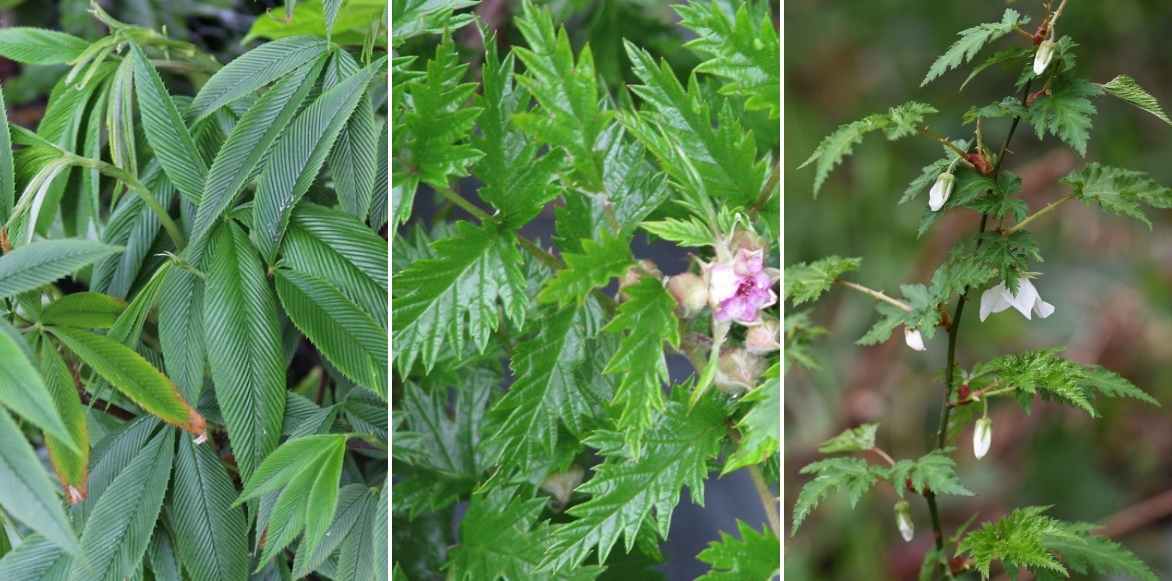
Rubus lineatus vietnamiensis and Rubus ludwigii (© Peganum), Rubus palmatus
- Ornamental brambles for their flowers: Rubus odoratus with pink flowers, Rubus X tridel ‘Benenden’ with large white flowers, Rubus amabilis with very large white flowers, Rubus X ‘Walberton’ with large pink flowers, Rubus spectabilis ‘Flore Pleno’ with very bright pink flowers, Rubus ulmifolius ‘Bellidiflorus’ with soft pink double flowers… Some brambles can even be ornamental thanks to their fruits, such as the surprising Rubus illecebrosus with tasteless but very bright red fruits.
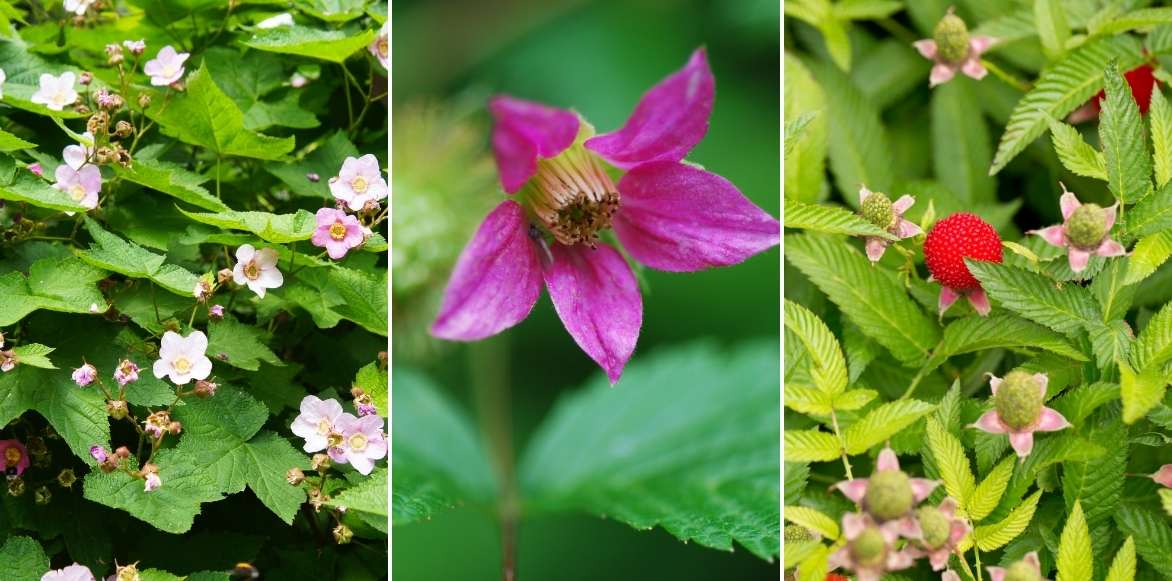
Rubus odoratus, Rubus spectabilis and Rubus illecebrosus
- Ornamental brambles for their coloured wood: Rubus thibetanus ‘Silver Fern’, Rubus cockburnianus (including ‘Golden Vale’ with golden foliage), Rubus fockeanus (no more than 5 cm tall!) and Rubus biflorus. All three have white branches. Rubus phoenicolasius with carmine red wood and Rubus ‘Darts Mahogany’ with mahogany wood.
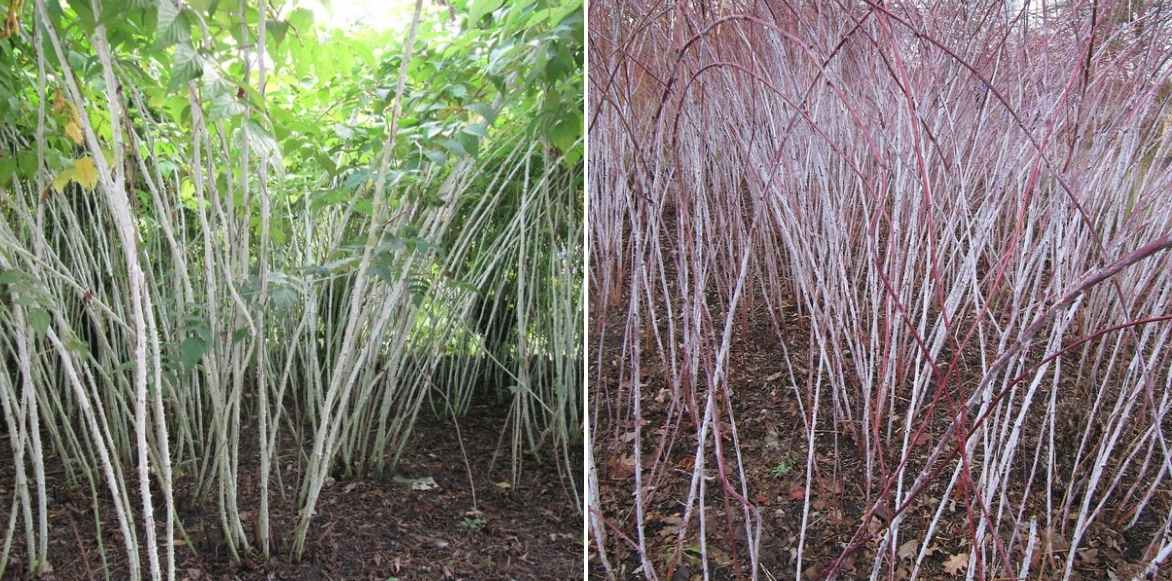
Rubus biflorus and Rubus cockburnianus (© L Enking)
- Groundcover ornamental brambles: Rubus tricolor, Rubus tricolor ‘Betty Ashburner’, Rubus buergeri, Rubus arcticus, Rubus calycinoides, Rubus rolfei, Rubus ichangensis, Rubus pectinaroides, Rubus pectinellus… We can also add Rubus henryi var. bambusarum and Rubus flagelliflorus which can be grown as climbers or as groundcover.
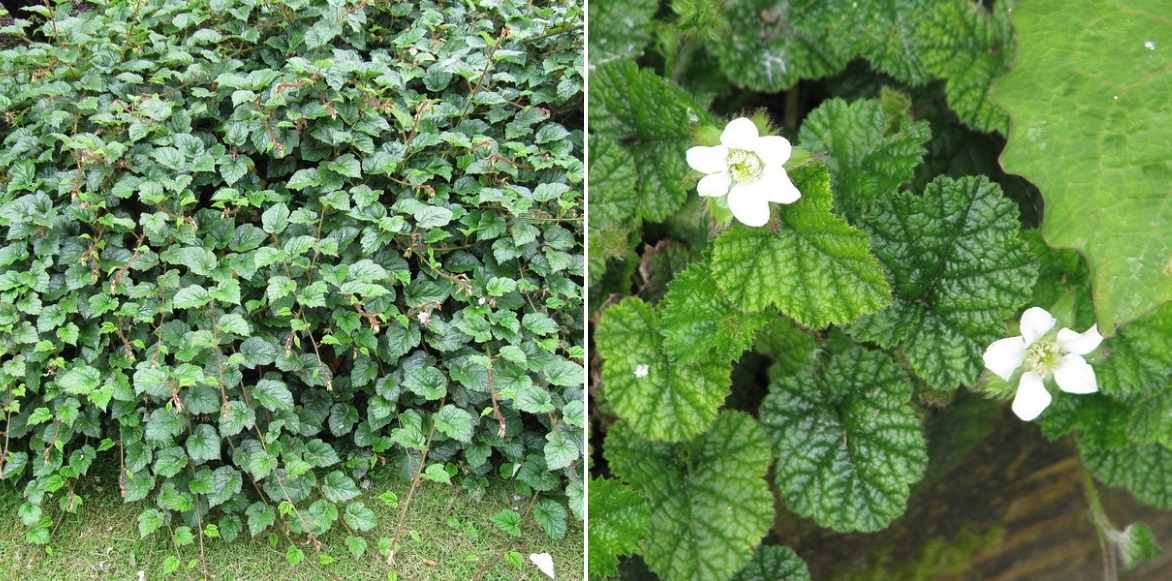
Rubus tricolor (© L Enking) and Rubus pectinellus trilobus (© Peganum)
Our favourite ornamental bramble varieties
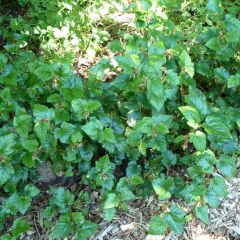
Rubus tricolor Betty Ashburner
- Flowering time July, August
- Height at maturity 50 cm
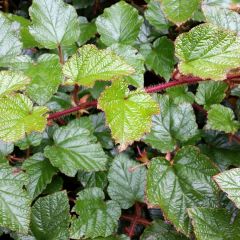
Rubus tricolor
- Flowering time July, August
- Height at maturity 60 cm
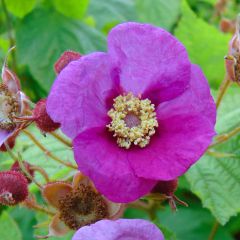
Rubus odoratus
- Flowering time July to September
- Height at maturity 1,50 m
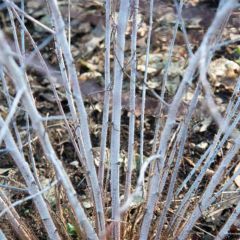
Rubus thibetanus Silver Fern
- Flowering time July, August
- Height at maturity 2 m
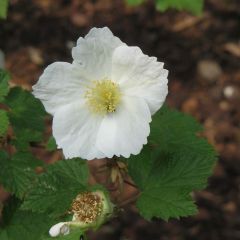
Rubus tridel Benenden
- Flowering time June, July
- Height at maturity 2,50 m
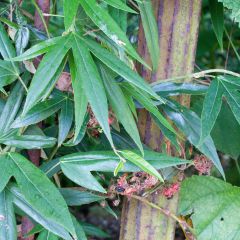
Rubus henryi bambusarum
- Flowering time June, July
- Height at maturity 6 m
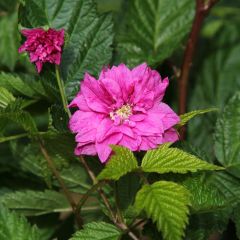
Rubus spectabilis Olympic Double
- Flowering time May, June
- Height at maturity 1,50 m
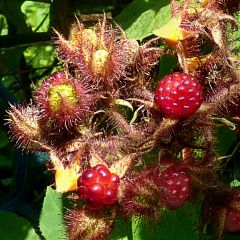
Rubus phoenicolasius 'Raisin du Japon' - Wineberry
- Flowering time June to August
- Height at maturity 3 m
Discover other Rubus - Blackberry
View all →Available in 0 sizes
Available in 1 sizes
Available in 2 sizes
Available in 1 sizes
Available in 1 sizes
Available in 1 sizes
Available in 1 sizes
Available in 1 sizes
Available in 1 sizes
Available in 1 sizes
Planting
Where to plant?
The preferred exposure will be full sun, but most ornamental brambles also thrive in light shade. Some species from dense forests, such as Henry’s Bramble, can grow in the shade.
Ornamental brambles are not particularly fussy about soil quality. However, for them to perform at their best, the soil should be rich and humus-bearing, remaining moist throughout the year, although Rubus are quite drought-resistant once established. The soil can be heavy or very light; it doesn’t matter. And the soil pH does not affect the growth of brambles.
When to plant?
Either in autumn: between September and November, or in spring: from March to April.
How to plant?
- Soak the pot in lukewarm water until the air bubbles escape from the root ball;
- Remove your Rubus from the pot and check that the roots are not too tangled and have not formed an inextricable knot;
- If they are, gently try to “untangle” the root ball to free the main roots; you can also remove any damaged or dry roots;
- Dig a hole twice as wide and deep as the root ball of the bramble;
- Loosen the bottom of the hole well and add some well-rotted manure and a few good handfuls of compost;
- Place the root ball of your Rubus at the bottom of the hole and fill the empty spaces with the excavated soil;
- Gently firm the soil around the base of your bramble to create a sort of mini-basin;
- Water thoroughly to eliminate any air pockets between the soil and the roots of your bramble.
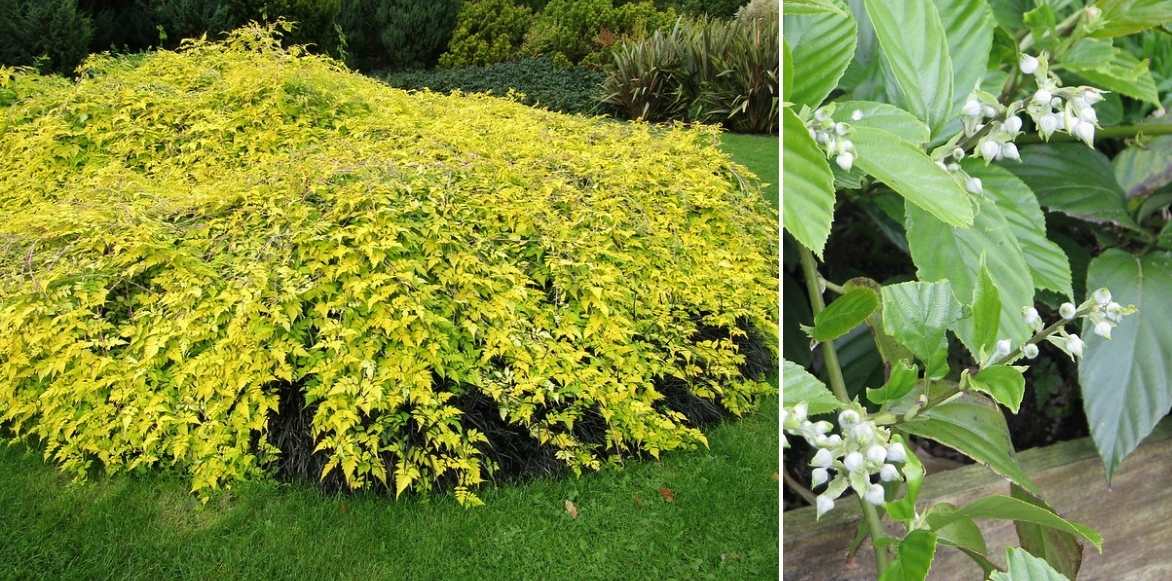
Rubus Cockburnianus ‘Golden Vale’ (© Leonora Enking), and Rubus acuminatus (© Peganum)
Care
Rubus are plants that require very little maintenance. However, they will need pruning once a year.
Groundcover Rubus should be sheared close to the soil in April to maintain a compact carpet.
The other ornamental brambles should also be pruned: old dry “canes” that are two years old and have already fruited should be removed at the base in April-May.
Propagation
Multiplication is quite easy, as brambles are very vigorous plants.
Layering
One solution is to gently lay a stem down to the ground in spring and hold it in place, either with a metal peg or simply with a not-too-heavy stone to avoid crushing the tissues. The stem on the ground will quickly produce roots, and you can then cut above and retrieve the sucker to plant elsewhere in autumn.
Chinese layering even allows for multiple new plants to be obtained from a single laid stem. In this case, you simply need to secure a long stem to the ground at different points using pegs or metal pins. This technique is very easy with groundcover brambles that naturally “layer”.
Suckers and stolons
A good number of ornamental brambles produce suckers. In this case, you just need to gently separate the rooted sucker from the mother plant and replant it elsewhere. This operation can be done in spring and autumn. Other ornamental brambles spread by stolons to colonise the surface (for example, Rubus tricolor). You simply need to cut the stem that connects the young shoot to the mother plant, then move the young seedling as needed.
Propagation by cuttings
Propagation by hardwood cuttings in autumn is possible with an excellent success rate. In this case, you need to take pieces of stem about 20 cm long and the diameter of a pencil, then push them into a potting mix, in a trench filled with sand in the garden, or… directly into the ground at the final location. In spring, you should see leaves developing. You can only proceed with planting in autumn (if the cutting was not done in place).
Propagation in water is as simple as it is effective with Rubus. Take a piece of terminal shoot about fifteen centimetres long in June-July. Remove the leaves, keeping only the last two. Place it in water and in light, and wait for roots to appear within 2 to 3 weeks (sometimes even sooner!). Once the roots have appeared, do not delay in potting it up in a light substrate. PS: remember to change the water every 3-4 days!
Pairing ideas
Colour for winter
The silver-white stems of Rubus thibetanius ‘Silver Fern’ are spectacular once the deciduous foliage has fallen. To enhance the white, what could be better than bare, colourful stems? Let’s adopt colourful dogwoods without delay to intertwine with the “bramble”: a Cornus sericea ‘Flaviramea’ with yellow stems in winter, a Cornus alba ‘Bâton Rouge’ with bright red stems, and a Cornus sanguinea ‘Winter Beauty’ with orange stems will be perfect. As a colourful groundcover in winter, we could plant a whole carpet of winter heathers with pink flowers like Erica X darleyensis ‘Kramer’s Rote’. In the background, two or three Himalayan birches with immaculate white bark will be perfect to echo the white stems of the Tibetan bramble.
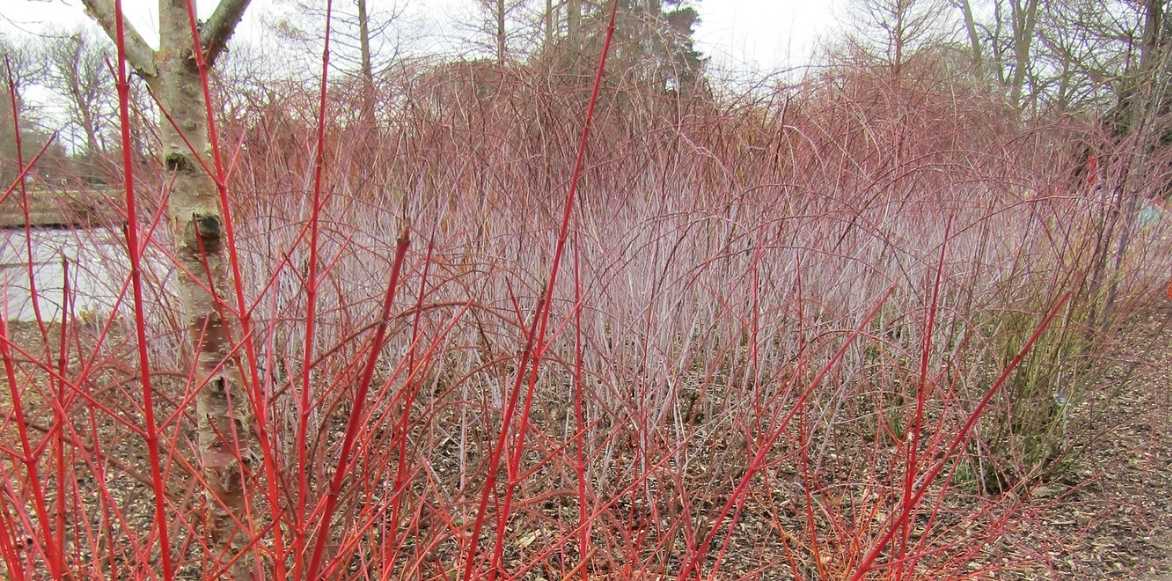
A beautiful association of winter colours with dogwoods with reddened stems, Rubus with white stems, and a few birches (© Leonora Enking)
A wild and… edible hedge
The basic idea is simple: a hedge made up of native or wild-looking shrubs or very small trees, providing shelter and cover for wildlife… and a few small fruits for gardeners. Depending on the space available or the effect desired, one can choose a male dogwood with golden foliage, a common medlar, a beautiful ‘Black Lace’ elder, an Amelanchier lamarckii, a few small currants, blackcurrants, gooseberries, and jostaberries in the foreground… And of course, ornamental or fruiting brambles that also produce good little fruits: Rubus spectabilis ‘Flore Pleno’ (or ‘Olympic Double’) with slightly bland orange fruits, but very good in jam, and a Rubus phoenicolasius with tangy fruits. One can also add raspberries and thornless fruiting brambles like Rubus fructicosus ‘Thornfree’.
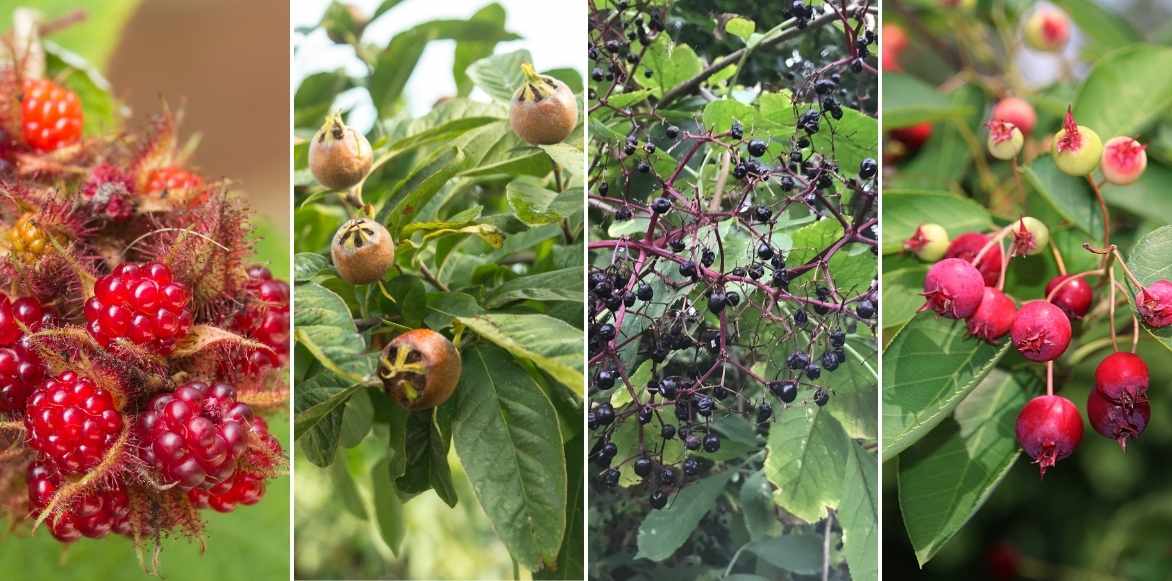
Rubus phoenicolasius, Mespilus (Medlar), Sambucus (Elder) and Amelanchier
An original duet of climbers
Among ornamental brambles, there are also quite vigorous climbers that can be grown on a solid support (pergola, trellis, or even a large tree) like Henry’s bramble or Rubus henryi var. bambusarum. To soften the reddish-pink colour of the flowers of this bramble, it can be paired with a lovely clematis with lilac-pink flowers: Clematis ‘Sans soucis’.
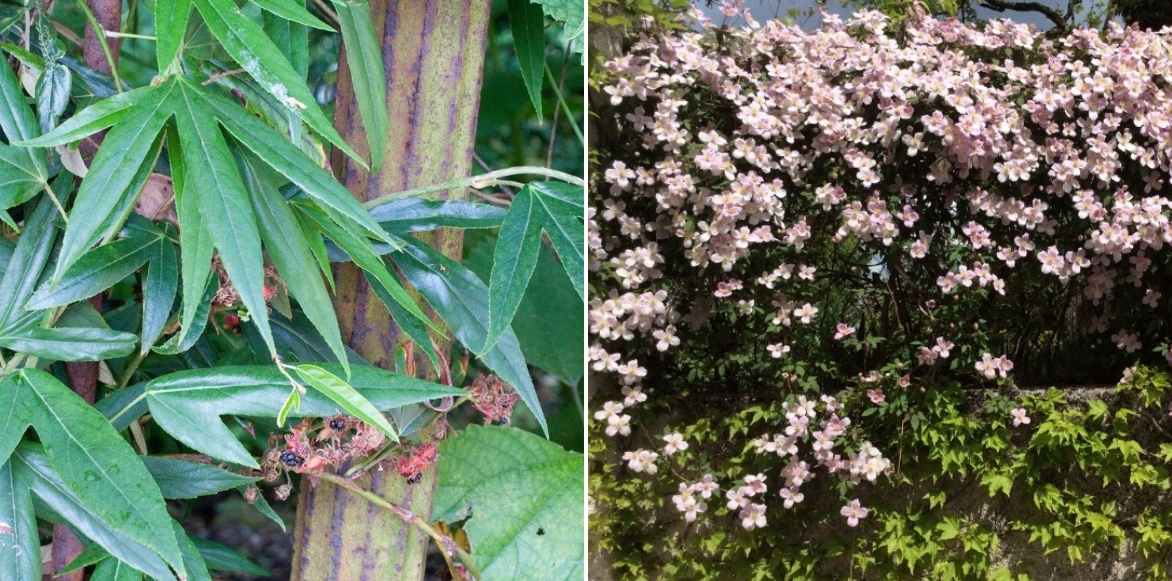 Rubus henryi var. bambusarum alongside Clematis montana ‘Sans Soucis’
Rubus henryi var. bambusarum alongside Clematis montana ‘Sans Soucis’
Anecdotes and possible remarks
- A planting of fruiting or ornamental brambles is called a bramble patch… while a population of wild brambles is more commonly referred to as a bramble thicket;
- In everyday language, the fruit of the bramble is called a “bramble berry” and thus, by extension, the plant is sometimes referred to as a “bramble bush“. However, do not confuse it with true mulberries, the small trees of the genus Morus;
- The vernacular name “bramble” derives from the Latin “Rumex“, which means “thorn“, in relation to the thorns of certain Rubus;
- “Rubus”, on the other hand, relates in Latin to “Ruber“, the colour red, likely due to the colour of the juice of the fruits;
- The classification of Rubus is so complicated, particularly due to unstable hybridization, that it has become a specialty for some botanists: Batology (from the Greek “batos“, meaning “bramble“). These botanists are then referred to as batologists or, more simply, rubologists.
Useful resources
→ Find all our ornamental brambles in our online nursery.
→ You can also find all our fruiting brambles, the blackberries, by following this link.
→ Raspberries are also Rubus, find them on our site!
→ Ornamental brambles: Christine tells you everything!
- Subscribe!
- Contents































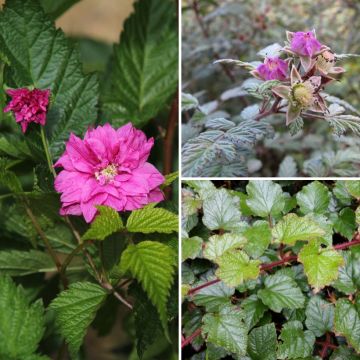



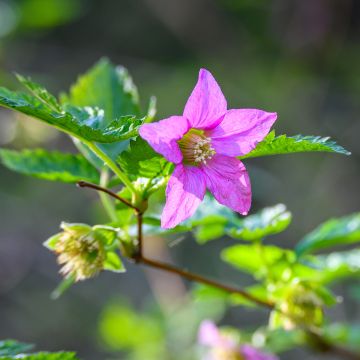

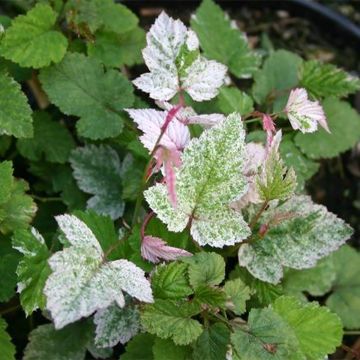



Comments